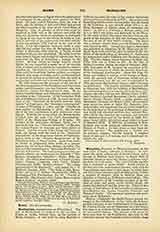

Mamertus, Saint, Bishop of Vienne, date of birth unknown; d. shortly after 475. Concerning the life of Mamertus before his elevation to the See of Vienne, nothing certain is known. The fact that his brother, Claudianus Mamertus, the theological writer, received in his youth a sound training in rhetoric, and enjoyed the personal acquaintance of Bishop Eucherius of Lyons (434-50), suggests that the brothers belonged to a wealthy Gallic family from the neighborhood of Lyons. Like his brother, St. Mamertus was distinguished for his knowledge of profane subjects as well as of theology, and, before his elevation to the episcopate, appears to have been married. His election and consecration took place shortly before 462. As bishop he enlisted the services of his brother, who had withdrawn to a cloister, and ordained him priest of Vienne. The activity of the brothers is described in a letter of Sidonius Apollinaris (Epist., IV, xi), another of whose letters (VII, i) is addressed to Bishop Mamertus. In 463 Mamertus was engaged in a dispute with Pope Hilarius on the question of the privileges of the Bishop of Arles. Pope Leo I had regulated the boundaries of the ecclesiastical provinces of Arles and Vienne: under the latter he left the Dioceses of Valence, Tarentaise, Geneva, and Grenoble, but all the other dioceses in this district were made subordinate to Arles. Regardless of this decision and infringing on the rights of his colleague of Arles, Mamertus consecrated in 463 a bishop for the city of Die (Dea). King Gundiac of Burgundy complained to Pope Hilary of this action, whereupon the latter wrote to Bishop Leontius of Arles on October 10, 463, bidding him summon a synod of bishops from the different provinces to enquire into the matter. In a subsequent letter to the bishops of the provinces of Lyons, Vienne, Narbonnensis I and II, and Alpina, he also refers to the matter, and directs them to obey Leontius’s summons to a regularly constituted synod (Thiel, “Epist. Rom. Pont.”, I, cxlvi, cli; Jaffe, “Regesta Rom. Pont.”, I, 2nd ed., dlvi, dlix). The synod decided against Mamertus, as we learn from another letter of the pope dated February 25, 464 (Thiel, op. cit., I, cxlviii; Jaffe, op. cit., I, dlvii). In this Hilary declares that Mamertus and the bishop unlawfully consecrated by him should really be deposed; desiring, however, that clemency be used, he commissioned Bishop Veranus to inform Mamertus that, if he did not recognize and submit to the regulations of Pope Leo, he would be deprived also of the four suffragan dioceses, still subject to Vienne_ The bishop invalidly installed by Mamertus was to be confirmed in his office by Leontius, after which he might retain the bishopric. Mamertus evidently submitted, since we find no subsequent reference to the incident.
During his episcopate, the remains of St. Ferreolus were discovered, and were translated by Mamertus to a church in Vienne, built in honor of that holy martyr (Gregory of Tours, “De gloria mart.”, II, ii). St. Mamertus was the founder of the Rogation Processions (see Rogation Days), as we learn on the testimony of Sidonius Apollinaris (Epist., V, xiv; VII, i), and his second successor, Avitus (“Homilia de Rogat.” in P.L.) LIX, 289-94). In connection with these intercessory processions, Mamertus summoned a synod at Vienne between 471 and 475. About 475 he attended a synod at Arles, which dealt with the predestination teaching of Lucidus, a Gallic priest. As this is the latest information we possess concerning him, we may assume that he died shortly afterwards. After his death he was venerated as a saint. His name stands in the “Martyrologium Hieronymianum” and in the “Martyrologium” of Florus of Lyons under May 11, on which day his feast is still celebrated (Quentin, “Les martyrologes historiques”, 348).
J. P. KIRSCH

